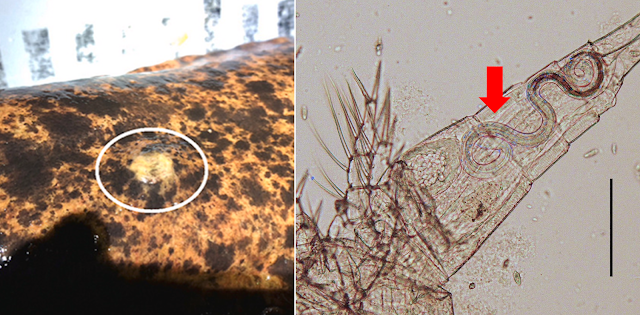The electric eel, also known as poraquê, is a formidable animal. Not only is it capable of stunning its prey with an electrifying shock, it can leap out of the water to deliver a powerful jolt to any larger animals (including humans) unwise enough to approach it. Anyone would think twice about laying a finger on one of those living tasers. And yet, there's Dolops discoidalis, a humble little fish louse which makes its living by clinging to and sucking blood from these slippery shockers.
 |
| Top left: an adult Dolops discoirdalis, Top right: A D. discoidalis on the skin of an electric eel. Bottom: A electric eel in an observation tank, with a hand wearing protective glove reaching towards it with a pair of tweezers. Photos from Fig. 1 of the paper |
Dolops discoidalis is a branchiuran - a group of ectoparasitic crustaceans which are related to the endoparasitic tongue worms. Branchiurans are commonly called "fish lice" and they cling onto the skin of their slippery hosts with all kinds of gnarly equipment. Some of them such as Argulus, have a pair of massive suckers which have been modified from the crustacean's mouthpart. But in the case of Dolops, they have a pair of stout, sickle-like hooks - and they'll need those to cling to a smooth-skinned fish like the electric eel.
A group of researchers were collecting electric eels at the Xingu River to study their physiology and behaviour when they noticed that the eels were not alone. The six electric eels they collected were all covered in little fish lice, which the researchers identified as belonging to a species called Dolops discoidalis, and it is the first ectoparasite to be reported from the electric eel. Each of those fish lice was about the size of your fingernails, and they scuttled freely over the eel's skin.
Electric eels are usually solitary animals, but sometimes they get together to hunt in packs, which may provide opportunities for these parasitic crustaceans to jump onto new hosts. Dolops discoidalis is widely distributed across the Amazon Basin, living on many different types of fishes, but it seem to have a preference for smooth scaleless fish, such as the spotted tiger shovelnose catfish.
It is unclear why D. discoidalis isn't affected by their host's powerful electrical discharges, but then again the electric eel is not the only electrical fish to host external parasites. Torpedo rays are known to harbour tiny blood-sucking isopods which are kind of like "ticks of the sea", and they also sometimes fall victim to parasitic snails that slowly creep up on those electrifying sea pancakes to suck their blood. So there might be other species of ectoparasites living on the electric eel which we don't know about yet. It's just that handling a slippery fish that can shock you with electricity can be extremely tricky, let alone trying to study the tiny things living on it.
So while being a living taser is certainly useful for getting a feed or scaring off any would-be predators, it is no deterrent to much tinier creatures which might see you as just another big, moveable feast.
Reference:
Silva, J. O. S., Sousa, L., de Paula, E. A., Takemoto, R. M., & Carvalho, L. N. (2025). First documented case of ectoparasitism in electric eel: Dolops discoidalis (Branchiura: Argulidae) infesting Electrophorus voltai (Teleostei: Gymnotidae). Parasitology International 109:103114.






.png)

